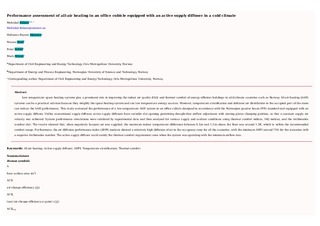| dc.contributor.author | Rabani, Mehrdad | |
| dc.contributor.author | Madessa, Habtamu Bayera | |
| dc.contributor.author | Nord, Natasa | |
| dc.contributor.author | Schild, Peter | |
| dc.contributor.author | Mysen, Mads | |
| dc.date.accessioned | 2019-04-15T06:11:29Z | |
| dc.date.available | 2019-04-15T06:11:29Z | |
| dc.date.created | 2019-04-13T06:22:12Z | |
| dc.date.issued | 2019 | |
| dc.identifier.issn | 0360-1323 | |
| dc.identifier.uri | http://hdl.handle.net/11250/2594558 | |
| dc.description.abstract | Low-temperature space heating systems play a prominent role in improving the indoor air quality (IAQ) and thermal comfort of energy efficient buildings in cold-climate countries such as Norway. All-air heating (AAH) systems can be a practical solution because they simplify the space heating system and use low temperature energy sources. However, temperature stratification and deficient air distribution in the occupied part of the room can reduce the AAH performance. This study evaluated the performance of a low-temperature AAH system in an office cubicle designed in accordance with the Norwegian passive house (PH) standard and equipped with an active supply diffuser. Unlike conventional supply diffuser, active supply diffusers have variable slot opening permitting draught-free airflow adjustment with moving plates changing position, so that a constant supply air velocity was achieved. System performance simulations were validated by experimental data and then analysed for various supply and outdoor conditions using thermal comfort indices, IAQ indices, and the Archimedes number (Ar). The results showed that, when negatively buoyant air was supplied, the maximum indoor temperature difference between 0.1m and 1.1m above the floor was around 1.5K, which is within the recommended comfort range. Furthermore, the air diffusion performance index (ADPI) analysis showed a relatively high diffusion of air in the occupancy zone for all the scenarios, with the minimum ADPI around 75% for the scenarios with a negative Archimedes number. The active supply diffuser could satisfy the thermal comfort requirement even when the system was operating with the minimum airflow rate. | nb_NO |
| dc.language.iso | eng | nb_NO |
| dc.publisher | Elsevier | nb_NO |
| dc.rights | Attribution-NonCommercial-NoDerivatives 4.0 Internasjonal | * |
| dc.rights.uri | http://creativecommons.org/licenses/by-nc-nd/4.0/deed.no | * |
| dc.title | Performance assessment of all-air heating in an office cubicle equipped with an active supply diffuser in a cold climate | nb_NO |
| dc.type | Journal article | nb_NO |
| dc.type | Peer reviewed | nb_NO |
| dc.description.version | acceptedVersion | nb_NO |
| dc.source.journal | Building and Environment | nb_NO |
| dc.identifier.doi | 10.1016/j.buildenv.2019.04.017 | |
| dc.identifier.cristin | 1692079 | |
| dc.description.localcode | © 2019. This is the authors’ accepted and refereed manuscript to the article. This manuscript version is made available under the CC-BY-NC-ND 4.0 license http://creativecommons.org/licenses/by-nc-nd/4.0/ | nb_NO |
| cristin.unitcode | 194,64,25,0 | |
| cristin.unitname | Institutt for energi- og prosessteknikk | |
| cristin.ispublished | true | |
| cristin.fulltext | postprint | |
| cristin.qualitycode | 2 | |

